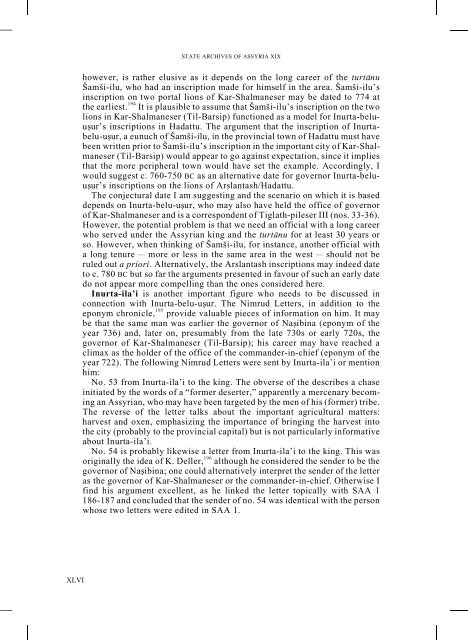Download PDF version of SAA 19 introduction - UCL
Download PDF version of SAA 19 introduction - UCL
Download PDF version of SAA 19 introduction - UCL
Create successful ePaper yourself
Turn your PDF publications into a flip-book with our unique Google optimized e-Paper software.
STATE ARCHIVES OF ASSYRIA XIX<br />
however, is rather elusive as it depends on the long career <strong>of</strong> the turta − nu<br />
Šamši-ilu, who had an inscription made for himself in the area. Šamši-ilu’s<br />
inscription on two portal lions <strong>of</strong> Kar-Shalmaneser may be dated to 774 at<br />
the earliest. <strong>19</strong>4 It is plausible to assume that Šamši-ilu’s inscription on the two<br />
lions in Kar-Shalmaneser (Til-Barsip) functioned as a model for Inurta-beluuṣur’s<br />
inscriptions in Hadattu. The argument that the inscription <strong>of</strong> Inurtabelu-uṣur,<br />
a eunuch <strong>of</strong> Šamši-ilu, in the provincial town <strong>of</strong> Hadattu must have<br />
been written prior to Šamši-ilu’s inscription in the important city <strong>of</strong> Kar-Shalmaneser<br />
(Til-Barsip) would appear to go against expectation, since it implies<br />
that the more peripheral town would have set the example. Accordingly, I<br />
would suggest c. 760-750 BC as an alternative date for governor Inurta-beluuṣur’s<br />
inscriptions on the lions <strong>of</strong> Arslantash/Hadattu.<br />
The conjectural date I am suggesting and the scenario on which it is based<br />
depends on Inurta-belu-uṣur, who may also have held the <strong>of</strong>fice <strong>of</strong> governor<br />
<strong>of</strong> Kar-Shalmaneser and is a correspondent <strong>of</strong> Tiglath-pileser III (nos. 33-36).<br />
However, the potential problem is that we need an <strong>of</strong>ficial with a long career<br />
who served under the Assyrian king and the turta − nu for at least 30 years or<br />
so. However, when thinking <strong>of</strong> Šamši-ilu, for instance, another <strong>of</strong>ficial with<br />
a long tenure — more or less in the same area in the west — should not be<br />
ruled out a priori. Alternatively, the Arslantash inscriptions may indeed date<br />
to c. 780 BC but so far the arguments presented in favour <strong>of</strong> such an early date<br />
do not appear more compelling than the ones considered here.<br />
Inurta-ila’i is another important figure who needs to be discussed in<br />
connection with Inurta-belu-uṣur. The Nimrud Letters, in addition to the<br />
eponym chronicle, <strong>19</strong>5 provide valuable pieces <strong>of</strong> information on him. It may<br />
be that the same man was earlier the governor <strong>of</strong> Naṣibina (eponym <strong>of</strong> the<br />
year 736) and, later on, presumably from the late 730s or early 720s, the<br />
governor <strong>of</strong> Kar-Shalmaneser (Til-Barsip); his career may have reached a<br />
climax as the holder <strong>of</strong> the <strong>of</strong>fice <strong>of</strong> the commander-in-chief (eponym <strong>of</strong> the<br />
year 722). The following Nimrud Letters were sent by Inurta-ila’i or mention<br />
him:<br />
No. 53 from Inurta-ila’i to the king. The obverse <strong>of</strong> the describes a chase<br />
initiated by the words <strong>of</strong> a “former deserter,” apparently a mercenary becoming<br />
an Assyrian, who may have been targeted by the men <strong>of</strong> his (former) tribe.<br />
The reverse <strong>of</strong> the letter talks about the important agricultural matters:<br />
harvest and oxen, emphasizing the importance <strong>of</strong> bringing the harvest into<br />
the city (probably to the provincial capital) but is not particularly informative<br />
about Inurta-ila’i.<br />
No. 54 is probably likewise a letter from Inurta-ila’i to the king. This was<br />
originally the idea <strong>of</strong> K. Deller, <strong>19</strong>6 although he considered the sender to be the<br />
governor <strong>of</strong> Naṣibina; one could alternatively interpret the sender <strong>of</strong> the letter<br />
as the governor <strong>of</strong> Kar-Shalmaneser or the commander-in-chief. Otherwise I<br />
find his argument excellent, as he linked the letter topically with <strong>SAA</strong> 1<br />
186-187 and concluded that the sender <strong>of</strong> no. 54 was identical with the person<br />
whose two letters were edited in <strong>SAA</strong> 1.<br />
XLVI

















